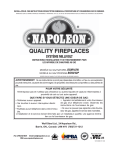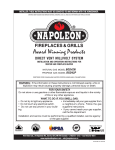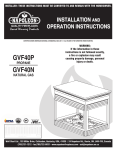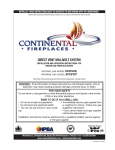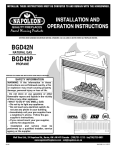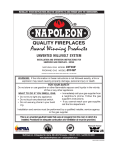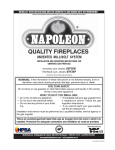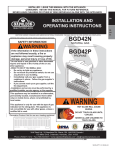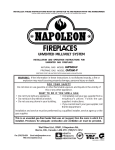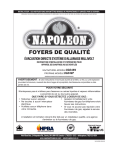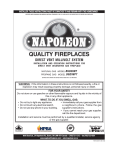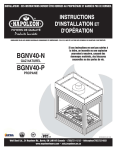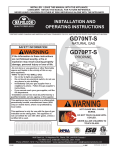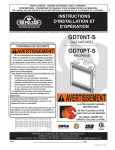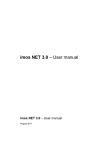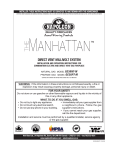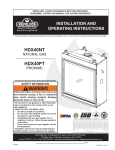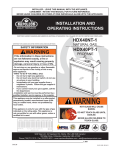Download Napoleon Grills BGNV42N User's Manual
Transcript
1 INSTALLER: THESE INSTRUCTIONS MUST BE CONVEYED TO AND REMAIN WITH THE HOMEOWNER. CERTIFIED UNDER CANADIAN AND AMERICAN NATIONAL STANDARDS, CSA 2.22, AND ANSI Z21.50 RESPECTIVELY FOR VENTED GAS FIREPLACES. MILLIVOLT SYSTEM INSTALLATION AND OPERATION INSTRUCTIONS FOR VENTED GAS FIREPLACE BGNV42N MODEL BGNV42P NATURAL GAS MODEL PROPANE GAS CERTIFIED FOR CANADA AND UNITED STATES USING ANSI / CSA METHODS WARNING: If the information in these instructions is not followed exactly, a fire or explosion may result causing property damage, personal injury or death. FOR YOUR SAFETY Do not store or use gasoline or other flammable vapours and liquids in the vicinity of this or any other appliance. WHAT TO DO IF YOU SMELL GAS: • Do not try to light any appliance. • Immediately call your gas supplier from • Do not touch any electrical switch. a neighbour's phone. Follow the gas • Do not use any phone in your building. supplier's instructions. • If you cannot reach your gas supplier, call the fire department. Installation and service must be performed by a qualified installer, service agency or the gas supplier. R-2000 Wolf Steel Ltd., 24 Napoleon Rd., Barrie, ON L4M 4Y8 Canada • (705)721-1212 • fax(705)722-6031 www.napoleonfireplaces.com • [email protected] W415-0377 / 03.04.03 2 TABLE of CONTENTS PG 2-4 INTRODUCTION PG10 OPTIONAL BLOWER INSTALLATION 11 OPTIONAL FAN INSTALLATION OPTIONAL THERMOSTATIC SENSOR Warranty General Instructions General Information Care of Glass & Plated Parts 5 12-13 OPERATION / MAINTENANCE Operating Instructions Maintenance VENTING Vent Safety Switch Hi Limit Switch Venting Action Check 6-7 13 Pilot Burner Adjustment Venturi Adjustment INSTALLATION 14 Gas Installation Framing Nailing Tab Installation Mantle Clearances 8-9 ADJUSTMENTS REPLACEMENTS Ordering Replacement Parts Replacement Parts Accessories 15-16 FINISHING TROUBLE SHOOTING GUIDE Louvre Bracket Installation Door Removal & Installation Louvre Installation Logo Placement Log Placement Charcoal & Glowing Embers PLEASE RETAIN THIS MANUAL FOR FUTURE REFERENCE WARNING • Do not burn wood or other materials in this fireplace. • Adults and especially children should be alerted to the hazards of high surface temperatures and should stay away to avoid burns or clothing ignition. Supervise young children when they are in the same room as the fireplace. • Due to high temperatures, the fireplace should be located out of traffic and away from furniture and draperies. • Clothing or other flammable material should not be placed on or near the fireplace. • Any safety screen or guard removed for servicing must be replaced prior to operating the fireplace. • It is imperative that the control compartments, burners and circulating blower and its passageway in the fireplace and venting system are kept clean. The fireplace and its venting system should be inspected before use and at least annually by a qualified service person. More frequent cleaning may be required due to excessive lint from carpeting, bedding material, etc. The fireplace area must be kept clear and free from combustible materials, gasoline and other flammable vapours and liquids. • Under no circumstances should this fireplace be modified. • This fireplace must not be connected to a chimney flue pipe serving a separate solid fuel burning appliance. • Do not use this fireplace if any part has been under water. Immediately call a qualified service technician to inspect the fireplace and to replace any part of the control system and any gas control which has been under water. • Do not operate the fireplace with the glass door removed, cracked or broken. Replacement of the glass should be done by a licensed or qualified service person. Use only with a glass door certified with the fireplace. • Do not strike or slam shut the fireplace glass door. W415-0377 / 03.04.03 3 NAPOLEON gas fireplaces are manufactured under the strict Standard of the world recognized ISO 9001 : 2000 Quality Assurance Certificate. NAPOLEON products are designed with superior components and materials, assembled by trained craftsmen who take great pride in their work. The burner and valve assembly are leak and test-fired at a quality test station. The complete fireplace is thoroughly inspected by a qualified technician before packaging to ensure that you, the customer, receives the quality product that you expect from NAPOLEON. NAPOLEON GAS FIREPLACE PRESIDENT'S LIFETIME LIMITED WARRANTY The following materials and workmanship in your new NAPOLEON gas fireplace are warranted against defects for as long as you own the fireplace. This covers: combustion chamber, heat exchanger, stainless steel burner, phazer™ logs and embers, ceramic glass (thermal breakage only), gold plated parts against tarnishing, porcelainized enamelled components and aluminum extrusion trims. Electrical (110V and millivolt) components and wearable parts such as the blower, gas valve, thermal switch, switches, wiring, remote control, ignitor, gasketing, and pilot assembly are covered and NAPOLEON will provide replacement parts free of charge during the first year of the limited warranty. Labour related to warranty repair is covered free of charge during the first year. Repair work, however, requires the prior approval of an authorized company official. Labour costs to the account of NAPOLEON are based on a predetermined rate schedule and any repair work must be done through an authorized NAPOLEON dealer. CONDITIONS AND LIMITATIONS NAPOLEON warrants its products against manufacturing defects to the original purchaser only -- i.e., the individual or legal entity (registered customer) whose name appears on the warranty registration card filed with NAPOLEON -- provided that the purchase was made through an authorized NAPOLEON dealer and is subject to the following conditions and limitations: This factory warranty is nontransferable and may not be extended whatsoever by any of our representatives. The gas fireplace must be installed by a licenced, authorized service technician or contractor. Installation must be done in accordance with the installation instructions included with the product and all local and national building and fire codes. This limited warranty does not cover damages caused by misuse, lack of maintenance, accident, alterations, abuse or neglect and parts installed from other manufacturers will nullify this warranty. This limited warranty further does not cover any scratches, dents, corrosion or discolouring caused by excessive heat, abrasive and chemical cleaners nor chipping on porcelain enamel parts, mechanical breakage of PHAZER™ logs and embers, nor any venting components used in the installation of the fireplace. NAPOLEON warrants its stainless steel burners against defects in workmanship and material for life, subject to the following conditions: During the first 10 years NAPOLEON will replace or repair the defective parts at our option free of charge. From 10 years to life, NAPOLEON will provide replacement burners at 50% of the current retail price. In the first year only, this warranty extends to the repair or replacement of warranted parts which are defective in material or workmanship provided that the product has been operated in accordance with the operation instructions and under normal conditions. After the first year, with respect to this President's Limited Lifetime Warranty, NAPOLEON may, at its discretion, fully discharge all obligations with respect to this warranty by refunding to the original warranted purchaser the wholesale price of any warranted but defective part(s). After the first year, NAPOLEON will not be responsible for installation, labour or any other costs or expenses related to the reinstallation of a warranted part, and such expenses are not covered by this warranty. Notwithstanding any provisions contained in this President's Limited Lifetime Warranty, NAPOLEON’S responsibility under this warranty is defined as above and it shall not in any event extend to any incidental, consequential or indirect damages. This warranty defines the obligations and liability of NAPOLEON with respect to the NAPOLEON gas fireplace and any other warranties expressed or implied with respect to this product, its components or accessories are excluded. NAPOLEON neither assumes, nor authorizes any third party to assume, on its behalf, any other liabilities with respect to the sale of this product. NAPOLEON will not be responsible for: over-firing, downdrafts, spillage caused by environmental conditions such as rooftops, buildings, nearby trees, hills, mountains, inadequate vents or ventilation, excessive venting configurations, insufficient makeup air, or negative air pressures which may or may not be caused by mechanical systems such as exhaust fans, furnaces, clothes dryers, etc. Any damages to fireplace, combustion chamber, heat exchanger, brass trim or other component due to water, weather damage, long periods of dampness, condensation, damaging chemicals or cleaners will not be the responsibility of NAPOLEON. The bill of sale or copy will be required together with a serial number and a model number when making any warranty claims from your authorized dealer. The warranty registration card must be returned within fourteen days to register the warranty. NAPOLEON reserves the right to have its representative inspect any product or part thereof prior to honouring any warranty claim. ALL SPECIFICATIONS AND DESIGNS ARE SUBJECT TO CHANGE WITHOUT PRIOR NOTICE DUE TO ON-GOING PRODUCT IMPROVEMENTS. NAPOLEON® IS A REGISTERED TRADEMARK OF WOLF STEEL LTD. PATENTS U.S. 5.303.693.801 - CAN. 2.073.411, 2.082.915. © WOLF STEEL LTD. W415-0377 / 03.04.03 4 GENERAL INSTRUCTIONS CARE OF GLASS, AND PLATED PARTS THIS GAS FIREPLACE SHOULD BE INSTALLED AND SERVICED BY A QUALIFIED INSTALLER to conform with local codes. Installation practices vary from region to region and it is important to know the specifics that apply to your area, for example: in Massachusetts State: Do not use abrasive cleaners to clean plated parts. Buff lightly with a clean dry cloth. The fireplace is factory equipped with 3/16" thick tempered glass. Use only replacement glass available from your Napoleon dealer. Do not substitute materials. Clean the glass after the first 10 hours of operation with a recommended gas fireplace glass cleaner. Thereafter clean as required. Do not clean glass when hot! If the glass is not kept clean permanent discolouration and / or blemishes may result. • The fireplace damper must be removed or welded in the open position prior to installation of a fireplace insert or gas log. • The appliance off valve must be a “T” handle gas cock. • The flexible connector must not be longer than 36 inches. • The appliance is not approved for installation in a bedroom or bathroom unless the unit is a direct vent sealed combustion product. • WARNING: This product must be installed by a licensed plumber or gas fitter when installed within the commonwealth of Massachusetts. In absence of local codes, install the fireplace to the current National Fuel Gas Code, ANSI Z223.1, or the current CAN/CGA B149, Installation Codes. The fireplace and its individual shut off valve must be disconnected from the gas supply piping system during any pressure testing of that system at test pressures in excess of 1/2 psig (3.5 kPa). The fireplace must be isolated from the gas supply piping system by closing its individual manual shut off valve during any pressure testing of the gas supply piping system at test pressures equal to or less than 1/2 psig (3.5 kPa). When the fireplace is installed directly on carpeting, vinyl tile or other combustible material other than wood flooring, the fireplace shall be installed on a metal or wood panel extending the full width and depth. If the optional fan or blower is installed, the junction box must be electrically connected and grounded in accordance with local codes. In the absence of local codes, use the current CSA C22.1 CANADIAN ELECTRICAL CODE in Canada or the ANSI/NFPA 70 NATIONAL ELECTRICAL CODE in the United States. Use only accessories designed for and listed with your specific fireplace. Provide adequate ventilation and combustion air. Provide adequate accessibility clearance for servicing and operating the fireplace. Never obstruct the front opening of the fireplace. Objects placed in front of the fireplace must be kept a minimum of 48" away from the front face of the unit. For safe and proper operation of the fireplace follow the venting & operating instructions exactly. Provide a means for visually checking the vent connection to the fireplace after the fireplace is installed. In order to avoid the possibility of exposed insulation and vapour barrier coming into contact with the fireplace body, it is recommended that the walls of the fireplace enclosure be 'finished' (i.e.: drywall/sheetrock) as you would finish any other wall of the home. This will ensure that clearance to combustibles is maintained within the cavity. GENERAL INFORMATION FOR YOUR SATISFACTION, THIS FIREPLACE HAS BEEN TEST-FIRED TO ASSURE ITS OPERATION AND QUALITY! Maximum input for the fireplace is 28,500 BTU/h for natural gas and propane. When the fireplace is installed at elevations above 4,500ft, and in the absence of specific recommendations from the local authority having jurisdiction, the certified high altitude input rating shall be reduced at the rate of 4% for each additional 1,000ft. Minimum inlet gas supply pressure is 4.5 inches water column for natural gas and 11 inches water column for propane. Maximum inlet gas pressure is 7 inches water column for natural gas and 13 inches water column for propane. Manifold pressure under flow conditions is 3.5 inches water column for natural gas and 10 inches water column for propane. This fireplace is approved for bedroom and bed-sitting room installation. No external electricity (110 volts or 24 volts) is required for the gas system operation. Expansion / contraction noises during heating up and cooling down cycles are normal and are to be expected. W415-0377 / 03.04.03 FIGURE 1 5 VENTING This is a vented appliance and must be connected to a chimney in accordance with the current installation codes. In absence of local codes, install to the current National Fuel Gas Code, ANSI Z223.1, or the current CAN/CGA B149, Installation Codes. This model can be common-vented. A minimum six inch diameter (6"ø) B-vent or class A vent is required. A minimum 10' vent height is required. Secure the B-vent to the exhaust collar on the stove top with 3 screws. In cold climates, the use of a B-vent and an insulated chase is recommended. VENT SAFETY SWITCH This thermally activated switch, located in front of the draft hood, senses an increase in temperature and acts as a safety shut-off (See 'A' below). It shuts down the gas to the main burner in the event of a severe downdraft of air or a blocked or disconnected chimney flue. If the flue is blocked or has no "draw", the safety switch will automatically shut off the supply of gas to the main burner within 10 minutes. This switch must be manually reset by depressing the plunger. Refer to Figure 2. Tampering with the safety switch can result in carbon monoxide poisoning and possible death. HIGH LIMIT SWITCH This thermally activated switch, located in front of the draft hood, senses an increase in temperature and acts as a safety shut-off (See 'A' below). It shuts down the gas to the main burner in the unlikely event of the unit overheating. The HI Limit switch will automatically reset after the unit has cooled down, resuming gas flow to the main burner. VENT SAFETY SWITCH HIGH LIMIT SWITCH THERMOSTAT OR WALL SWITCH FIGURE 3 VALVE VENTING ACTION CHECK A test for correct venting action must be made before the installed unit can be left with the customer. Follow the procedure below: 1. Close all doors and windows in the room / start exhaust fans in the home / turn the fireplace blower off (if so equipped). 2. Set controls to "high" and light the unit. 3. Wait 5 minutes. Light a match and hold to the front of the draft hood. FIGURES 4 & 5. PLUNGER A HI LIMIT SWITCH FIGURE 4 Venting action is satisfactory, if smoke and flames are drawn into the draft hood. FIGURE 5 Venting action is unsatisfactory, if the smoke spills back, and the flame splays outward. If venting action is unsatisfactory, turn off the unit, wait 10 minutes and try again. If the smoke is still not drawn into the draft hood, turn the unit off and check for vent blockage or restriction. If necessary, consult with a qualified inspector. B 1 2 3 FIGURE 2 The Vent Safety or Hi Limit switches must not be adjusted or disabled. In the event that either switch or any associated parts are exchanged, only original manufacturer's parts may be used. W415-0377 / 03.04.03 6 INSTALLATION GAS INSTALLATION FRAMING Proceed once the vent installation is complete. 1. Move the fireplace into position and secure using the nailing tabs and/or secure to the floor through the 1/4"ø holes located at either end of the base. 2. Route a 3/8" N.P.T. black iron gas line, 1/2" type-L copper tubing or equivalent to the fireplace. 3. For ease of accessibility, an optional remote wall switch or millivolt thermostat may be installed in a convenient location. Route 2-strand (solid core) millivolt wire through the electrical hole located at the bottom left side of the unit. The recommended maximum lead length depends on wire size: WIRE SIZE MAX. LENGTH 14gauge 100 feet 16gauge 60 feet 18gauge 40 feet Attach the one lead to terminal 3 (located on the gas valve) and the other lead to the vent safety switch wire ( located loose in the valve compartment). See FIGURE 3. It is best to frame your fireplace after it is positioned. Use 2x4's and frame to local building codes. FIGURE 7-9. Note: In order to avoid the possibility of exposed insulation or vapour barrier coming in contact with the fireplace body, it is recommended that the walls of the fireplace enclosure be “finished” (ie: drywall/sheetrock), as you would finish any other outside wall of a home. This will ensure theat clearance to combustibles is maintained within the cavity. It is not necessary to install a hearth extension with this fireplace system. When roughing in the fireplace, raise the fireplace to accommodate for the thickness of the finished floor materials, i.e. tile, carpeting, hard wood, which if not planned for will interfere with the opening of the lower access door and the installation of many decorative flashing accessories. Objects placed in front of the fireplace should be kept a minimum of 4 feet away from the front face. Do not connect either the wall switch, thermostat or gas valve to electricity (110 volts). sides, back, bottom and top of the unit recessed depth 1 2 0 inch 22 inches O LO ON FF IH FIGURE 6 Minimum clearance to combustible construction from fireplace: PL T O I PI L OT 3 4. Install rigid black pipe, 1/2" type-L copper tubing or, if local codes permit, a 3/8" flex connector and shutoff valve to the gas line and the fireplace gas valve. Seal and tighten securely. An adapter fitting is required between the gas valve and the copper tubing or flex connector. DO NOT KINK FLEXIBLE CONNECTOR. FIGURE 6. 5. Check for gas leaks by brushing on a soap and water solution. FIGURES 8 Do not use open flame. FIGURE 7 FIGURE 9 Purge all gas lines with the glass door of the fireplace removed. Assure that a continuous gas flow is at the burner before installing the door. FIGURE 10 W415-0377 / 03.04.03 7 NAILING TAB INSTALLATION FIGURES 12a-c 1) Attach the nailing tabs to the corner posts using the 2 sheet metal screws supplied. Secure through the centre of the top and bottom slots in the nailing tab and then NAILING through the existing holes in TAB the corner posts. CORNER POST NAILING TAB TOP SLOT If there are no existing holes, follow these instructions: Position the nailing tab so that the front face is offset with the front edge of the corner post (approx. ½"). Centre the nailing tab vertically on the corner post. FIGURE11 Figure 12 a. Drill through the centre of the top and bottom slots in the nailing tab. Secure using the two sheet metal screws supplied. This allows the nailing tab to slide back and forth for desired framing. Figure 12 b. 2) To determine the final location of the nailing tab you must first determine the thickness of your finishing material (i.e. drywall). This will determine the dimension from the front edge of the corner post to the nailing tab. Once the nailing tab is in the desired location, drill through the centre hole of the nailing tab. Secure with a sheet metal screw*. Figure 12 c. * Additional set screws may be installed. A B FINISHING MANTLE CLEARANCES MATERIAL Combustible materials may be installed flush with the front of the fireplace but must not cover any of the black faceareas of the fireplace. Non-combustible material (brick, stone or ceramic tile) may protrude in these areas. Combustible mantle clearance can vary according to the mantle depth. Use the graph to help evaluate the clearance needed. Figures 11 a & b. FIGURE 13a CENTRE HOLE FIGURE 13b C W415-0377 / 03.04.03 8 FINISHING L42 LOUVRE INSTALLATION LOUVRE BRACKET INSTALLATION 1. Align the holes in the louvre brackets with the pre-drilled holes in the firebox, as shown. FIGURE 14 FIGURE 17 2. Secure louvre brackets in place using screws. A B DOOR INSTALLATION The upper louvres must be removed to allow the door to be removed. Release the two door latches, located across the top of the door and lift off the lower door bracket. GDL42 LOUVRE INSTALLATION Insert the upper louvres into the slots on both brackets. UPPERLOUVRE SLOT UPPER LOUVRES Insert the louvre tabs into the slots located at the top left and right corners of the unit. TA B 15 DOOR LATCH 16 HINGE SCREEN Attach each hinge on the lower louvre assembly to the lip of the fireplace base with 2 screws. Position the hinge screen into place and with the control door open, secure to the fireplace using three screws. A B HINGE SLOT CLIP LOWER LOUVRES Insert the hinge clips into the slots located at the bottom left and right corners of the unit. To remove the louvres, pull the back tabs of the clips forward, while pushing the louvre assembly back. Lift the clip. LOGO PLACEMENT Remove the backing of the logo supplied and place on the glass viewing door, as indicated. ½" LOGO ½" FIGURE 18 W415-0377 / 03.04.03 9 LOG PLACEMENT TM PHAZER logs and glowing embers, exclusive to Napoleon Fireplaces, provide a unique and realistic glowing effect that is different in every installation. Take the time to carefully position the glowing embers for a maximum glowing effect. Log colours may vary. During the initial use of the fireplace, the colours will become more uniform as colour pigments burn in during the heat activated curing process. FIGURES 19a-e #4 #5 #1 4. Place the bottom of the left crossover log (#4) against the left outermost grate post and the top into the pocket provided on the back log. Position the notch located on the end of the center log (#5) against the middle grate post with the other end of the log resting in the pocket of the left crossover log. 1. Place the back log (#1) onto the log support tray and in front of the tabs. The tabs maintain an air space between the log and firebox back to facilitate combustion air flow. Ensure that the back of the log rests against the brackets on the back wall of the firebox. #2 #6 #3 5. Place the bottom of the right crossover log (#6) against the right outermost grate post and the top into the pocket provided on the center log (#5). CHARCOAL EMBERS 2. Move the two small logs (#2 & #3) into position, lining up the studs located on the burner with the holes on the bottom of the logs. Randomly place the charcoal embers along the front and sides of the log support tray in a realistic manner. Fine dust found in the bottom of the bag should not be used. VERMICULITE GLOWING EMBERS 3. Tear the glowing embers into pieces and place along the front row of ports covering all of the burner area in front of the small logs (#2 & #3). Care should be taken to shred the embers into thin, small irregular pieces as only the exposed edges of the fibre hairs will glow. The ember material will only glow when exposed to direct flame; however, care should be taken to not block the burner ports. Blocked burner ports can cause an incorrect flame pattern, carbon deposits and delayed ignition. PHAZERTM logs glow when exposed to direct flame. Sprinkle vermiculite around the charcoal embers. Note: Both charcoal embers and vermiculite are not to be placed on the burner. CHARCOAL LUMPS Place the lumps between the logs in a realistic manner taking care not to block any of the burner ports. W415-0377 / 03.04.03 10 OPTIONAL BLOWER INSTALLATION INSTALLATION TO BE DONE BY A QUALIFIED INSTALLER and must be electrically connected and grounded in accordance with local codes. In the absence of local codes, use the current CSA C22.1 CANADIAN ELECTRICAL CODE in Canada or the ANSI/NFPA 70 NATIONAL ELECTRICAL CODE in the United States. Attach the connectors from the black and white wires to the thermodisc and secure the thermodisc bracket to the securing stud at the bottom left of the unit using a lock washer and wing nut. Ensure that the thermodisc touches the firebox wall. THERMODISC k blac red RECEPTACLE / JUNCTION B O X white GROUND SCREW FIGURE 20 FIGURE 24 The three slots allow ease of adjustment of the blower. For a quiet running blower, do not allow the assembly to sit on the firebox base. ADJUSTMENT SLOTS Attach the connectors from the black and red wires to the blower. Attach and secure the variable speed switch using the nut provided. Plug the harness cord into the receptacle. FIGURE 21 Slide the vibration reducing pad (A) into the clip and onto the threaded stud (B) at the other end, piercing a hole into the pad. The blower must be able to be positioned entirely onto the pad. Tilt the blower onto its side. Slide it past the controls and into the clip (C). Secure to the threaded stud using the lock washer and wing nut provided. Ensure that the blower does not touch the fireplace base or the firebox. B C A FIGURE 22 W415-0377 / 03.04.03 FIGURE 23 FIGURE 25 The wire harness provided in this kit is a universal harness. When installed, ensure that any excess wire is contained, preventing it from making contact with moving or hot objects. Because the blower is thermally activated, when turned on, it will automatically start approximately 15 minutes after lighting the fireplace and will run for approximately 30-45 minutes after the fireplace has been turned off. Use of the fan increases the output of heat. Drywall dust will penetrate into the blower bearings causing irreparable damage. Care must be taken to prevent drywall dust from coming into contact with the blower or its compartment. Any damage resulting from this condition is not covered by the warranty policy. 11 OPTIONAL FAN INSTALLATION ELECTRICAL INSTALLATION TO BE DONE BY A QUALIFIED INSTALLER and must be connected and grounded in accordance with local codes. In the absence of local codes, use the current CSA C22.1 CANADIAN ELECTRICAL CODE in Canada or the ANSI/NFPA 70 NATIONAL ELECTRICAL CODE in the United States. OPTIONAL THERMOSTATIC SENSOR RECEPTACLE / JUNCTION BOX FIGURE 27 VARIABLE SPEED/ PIEZO IGNITOR BRACKET OPEN ENDED SLOTS FIGURE 26 The wire harness provided in this kit is a universal harness. When installed, ensure that any excess wire is contained, preventing it from making contact with moving or hot objects. Position the vibration reducing pad into the clip and onto the threaded stud at the other end, piercing a hole into the pad. The fan assembly must be able to be positioned entirely onto the pad. Slide the fan assembly past the controls and and into the clip. Secure using the lock washer and nut provided. Plug the harness cord connectors onto the connections of the fan as illustrated. Plug the power cord into the receptacle. THERMOSTATIC SENSOR CONTROL This optional kit is meant to be used only in conjunction with the GD65 Fan Kit, shown above, which may be ordered from your Wolf Steel / Napoleon dealer. With the thermostatic sensor option, the fan, when turned on, becomes thermally activated, and will automatically run approximately 10 minutes after the fireplace has been lit and for approximately 30-45 minutes after the fireplace has been turned off. Use of the fan increases the output of heat. Unplug the power cord from the receptacle. Connect all wires as shown. Attach and secure the sensor assembly bracket to the securing stud located next to the receptacle/junction box at the bottom left of the unit using the lock washer and wing nut. Ensure that the thermodisc touches the firebox wall. Plug the power cord back into the receptacle. When installed, ensure that any excess wire is contained, preventing it from making contact with moving or hot objects. THERMODISC SENSOR ASSEMBLY BRACKET FIGURE 29 RECEPTACLE / JUNCTION BOX FIGURE 28 W415-0377 / 03.04.03 12 OPERATION / MAINTENANCE WHAT TO DO IF YOU SMELL GAS ON PL T Turn off all gas to the fireplace. Open windows. Do not try to light any appliance. Do not touch any electric switch; do GAS KNOB not use any phone in your building. • Immediately call your gas supplier from a neighbour's phone. Follow the gas supplier's instructions. • If you cannot reach your gas supplier, call the fire department. • • • • O FOR YOUR SAFETY READ BEFORE LIGHTING: A. This fireplace is equipped with a pilot which must be lit by hand while following these instructions exactly. B. Before operating smell all around the fireplace area for gas and next to the floor because some gas is heavier than air and will settle on the floor. C. Use only your hand to turn the gas control knob. Never use tools. If the knob will not turn by hand, do not try to repair it. Call a qualified service technician. Force or attempted repair may result in a fire or explosion. D. Do not use this fireplace if any part has been under water. Immediately call a qualified service technician to inspect the fireplace and replace any part of the control system and any gas control which has been under water. FF When lit for the first time, the fireplace will emit a slight odour for a few hours. This is a normal temporary condition caused by the curing of the logs and the "burn-in" of internal paints and lubricants used in the manufacturing process and will not occur again. After extended periods of non-operation such as following a vacation or a warm weather season, the fireplace may emit a slight odour for a few hours. This is caused by dust particles in the heat exchanger burning off. In both cases, open a window to sufficiently ventilate the room. Purge all gas lines with the glass door of the fireplace removed. Assure that a continuous gas flow is at the burner before installing the door. O I OPERATING INSTRUCTIONS LIGHTING INSTRUCTIONS WARNING: The gas valve has an interlock device which will not allow the pilot burner to be lit until the thermocouple has cooled. Allow approximately 60 seconds for the thermocouple to cool. When lighting and re-lighting, the gas knob cannot be turned from pilot to off unless the knob is depressed slightly. 1. Stop! Read the above safety information on this label. 2. Turn off all electric power to the fireplace. to off. 3. Turn the gas knob clockwise 4. Wait five (5) minutes to clear out any gas. If you smell gas including near the floor. Stop! Follow "B" in the above safety information on this label. If you don't smell gas go the next step. 5. Turn gas knob counter-clockwise to pilot. 6. Depress slightly and hold gas knob while lighting the pilot with the push button ignitor. Keep knob depressed for one minute, then release. If pilot does not continue to burn, repeat steps 3 through 5. 7. With pilot lit, depress and turn gas knob counter-clockwise to on. 8. If equipped with remote on-off switch/thermostat, main burner may not come on when you turn valve to on. Remote switch must be in the on position to ignite burner. 9. Turn on all electric power to the fireplace. TO TURN OFF GAS 1. Turn off all electric power to the fireplace if service is to be performed. W415-0377 / 03.04.03 2. Push in gas control knob slightly and turn clockwise to off. Do not force. 13 MAINTENANCE Turn off the gas and electrical power before servicing the fireplace. CAUTION: Label all wires prior to disconnection when servicing controls. Wiring errors can cause improper and dangerous operation. Verify proper operation after servicing. This fireplace and its venting system should be inspected before use and at least annually by a qualified service person. The fireplace area must be kept clear and free of combustible materials, gasoline or other flammable vapours and liquids. The flow of combustion and ventilation air must not be obstructed. 1. In order to properly clean the burner and pilot assembly, remove the logs to expose both assemblies. 2. Keep the control compartment, logs, burner, air shutter opening and the area surrounding the logs clean by vacuuming or brushing, at least once a year. 3. Check to see that all burner ports are burning. Clean out any of the ports which may not be burning or are not burning properly. 4. Check to see that the pilot flame is large enough to engulf the thermocouple and thermopile and reaches toward the burner with the third jet. 5. Replace the cleaned logs. 6. Check to see that the main burner ignites completely on all openings when the gas knob for the burner is turned on. A 5 to 10 second total light-up period is satisfactory. If ignition takes longer, consult your Napoleon dealer / distributor. 7. Check that the gasketing on the sides, top and bottom of the door is not broken or missing. Replace if necessary. ADJUSTMENTS PILOT BURNER ADJUSTMENT AIR SHUTTER ADJUSTMENT MUST ONLY BE DONE BY A QUALIFIED GAS INSTALLER! Adjust the pilot screw to provide properly sized flame. Turn in a clockwise direction to reduce the gas flow. FIGURE 29 O LO ON FF IH PL T O I PI LOT PILOT SCREW FIGURE 28 FIGURE 30 To access the air shutter, remove the two screws that secure the cover to the air housing, taking care not to damage the gasket. FIGURE 30 VENTURI ADJUSTMENT VENTURI MODEL BGNV42 NG 1/8" LP 5/16" Closing the air shutter will cause a more yellow flame, but can lead to carboning. Opening the air shutter will cause a more blue flame, but can cause flame lifting from the burner ports. The flame may not appear yellow immediately; allow 15 to 30 minutes for the final flame colour to be established. COVER FIGURE 31 (not exactly as shown) W415-0377 / 03.04.03 14 REPLACEMENTS Contact your dealer or the factory for questions concerning prices and policies on replacement parts. Normally all parts can be ordered through your Napoleon dealer or distributor. When ordering replacement parts always give the following information: FOR WARRANTY REPL ACEMENT PAR TS, A PHO TOCOPY OF THE REPLA ARTS PHOT ORIGINAL INVOICE WILL BE REQUIRED TO HONOUR THE CLAIM. 1. 2. 3. 4. 5. MODEL & SERIAL NUMBER OF FIREPLACE INSTALLATION DATE OF FIREPLACE PART NUMBER DESCRIPTION OF PART FINISH * IDENTIFIES ITEMS WHICH ARE NOT ILLUSTRATED. FOR FURTHER INFORMATION, CONTACT YOUR NAPOLEON DEALER. ACCESSORIES REPLACEMENT PARTS # PART NO. DESCRIPTION # PART No. DESCRIPTION 1 2 3 4 4 5* 6 6 7 7 8* 9* 10* 11 12 13* 14* 15* 16 17 18 19 20 21 22 23 23 24* W357-0001 W680-0004 W680-0005 W010-0800 W010-0801 W660-0005 W455-0069 W455-0068 W725-0035 W725-0034 W385-0245 W660-0005 W750-0051 W010-0877 GL-630 W361-0016 W550-0001 W550-0002 W135-0130 W135-0131 W135-0132 W135-0133 W135-0134 W135-0135 W010-0770 W455-0072 W455-0059 W361-0014 25 25 25 26 27 27 27 27 28* 29* 29* 30* 31* 31* 32 33* 34* 35* 36 37* 38* 39 GDL42K GDL42PB GDL42SS L42K GDOI42BG GDOI42K GDOI42G GDOI42SS W690-0001 W660-0010B W660-0011B W660-0013 GD825N GD825P GZ550-1KT GD65 GD36 W500-0033 GA-566 W690-0005 GA-70 GA-72 W415-0377 / 03.04.03 PIEZO IGNITER THERMOPILE THERMOCOUPLE NATURAL GAS PILOT ASSEMBLY - SIT PROPANE GAS PILOT ASSEMBLY - SIT ON/OFF TOGGLE SWITCH NATURAL GAS PILOT INJECTOR PROPANE GAS PILOT INJECTOR NATURAL GAS VALVE PROPANE VALVE NAPOLEON LOGO STANDARD WALL SWITCH 20FT OF WIRE PAN BURNER LOG SET GLOWING EMBERS CHARCOAL EMBERS CHARCOAL LUMPS BACK LOG (#1) LEFT CROSSOVER LOG (#4) CENTER LOG (#5) RIGHT CROSSOVER LOG (#6) SMALL LEFT LOG (#2) SMALL RIGHT LOG (#3) BLACK DOOR C/W GLASS #39 NATURAL GAS ORIFICE #53 PROPANE GAS ORIFICE VERMICULITE LOUVRE KIT - UPPER & LOWER - BLACK LOUVRE KIT - UPPER & LOWER - POLISHED BRASS LOUVRE KIT - UPPER & LOWER - BRUSHED STAINLESS STEEL LOUVRE KIT - UPPER & LOWER - BLACK ORNAMENTAL INSET - BRUSHED GOLD ORNAMENTAL INSET - BLACK ORNAMENTAL INSET - GOLD ORNAMENTAL INSET - STAINLESS STEEL MILLIVOLT THERMOSTAT REMOTE CONTROL - ADVANTAGE REMOTE CONTROL - ADVANTAGE PLUS MODULATING THERMOSTATIC HAND HELD REMOTE MODULATING VALVE REGULATOR FOR W660-0013 - NG MODULATING VALVE REGULATOR FOR W660-0013 - P BLOWER KIT FAN KIT THERMOSTATIC SENSOR CONTROL KIT FOR USE WITH GD65 ONLY VARIABLE SPEED SWITCH WALL MOUNTING PLATE HOT AIR DISTRIBUTION KIT THERMOSTAT - 110V FOR USE WITH GA-566 ONLY EXTENSION KIT - 5 FT HOT AIR EXHAUST KIT 15 TROUBLE SHOOTING GUIDE BEFORE ATTEMPTING TO TROUBLESHOOT, PURGE YOUR UNIT AND INITIALLY LIGHT THE PILOT AND THE MAIN BURNER WITH THE GLASS DOOR REMOVED. SYMPTOM PROBLEM TEST SOLUTION Main burner goes Pilot flame is not large - turn up pilot flame. out; pilot stays on. enough or not engulfing the - replace pilot assembly. thermopile Thermopile shorting - clean thermopile connection to the valve. Reconnect. - replace thermopile / valve. Remote wall switch wire is - shorten wire to correct length or wire gauge. too long; too much resistance in the system. Faulty thermostat or switch. - replace. Vent safety switch has opened. (Tripped) Hi Limit switch has opened. (Tripped) - Vent has become blocked or disconnected. Correct. See Figure 2. - Unit has overheated. See Figure 2 Main burner goes Refer to "MAIN BURNER GOES OUT; PILOT STAYS ON" out; pilot goes out. Faulty thermocouple. - replace. Pilot goes out when the gas knob is released. The gas valve has an interlock device which will not allow the pilot burner to be lit until the thermocouple has cooled. Allow approximately 60 seconds for the thermocouple to cool. System is not correctly - purge the gas line with the glass door open. purged. Pilot burning; no gas to main burner; gas knob is on 'HI'; wall switch / thermostat is on. Out of propane gas. - fill the tank. Pilot flame is not large - turn up the pilot flame. enough Pilot flame is not engulfing the thermocouple. Thermocouple shorting / faulty. - gently twist the pilot head to improve the flame pattern around the thermocouple. - loosen and tighten thermocouple. - clean thermocouple and valve connection. - replace thermocouple. Faulty valve. - replace. Themostat or switch is defective. Wall switch wiring is defective. - connect a jumper wire across the wall switch terminals; if main burner lights, replace switch / thermostat. - disconnect switch wires & connect a jumper wire across terminals 1 & 3; if the main burner lights, check the wires for defects and / or replace wires. - remove stoppage in orifice. Main burner orifice is plugged. - replace. Faulty valve. Vent safety switch has opened. - Vent has become blocked or disconnected. Correct. See Figure 2. (Tripped) Hi Limit switch has opened. (Tripped) - Unit has overheated. See Figure 2 Pilot will not light. No spark at pilot burner Out of propane gas Spark gap is incorrect No gas at the pilot burner - check if pilot can be lit by a match - check that the wire is connected to the push button ignitor. - check if the push button ignitor needs tightening. - replace the wire if the wire insulation is broken or frayed. - replace the electrode if the ceramic insulator is cracked or broken. - replace the push button ignitor. - fill the tank. - spark gap should be 0.150" to 0.175" (5/32" to 11/64" approx.) from the electrode tip and the pilot burner. To ensure proper electrode location, tighten securing nut (finger tight plus 1/4 turn). - check that the manual valve is turned on. - check the pilot orifice for blockage. - replace the valve. - call the gas distributor. W415-0377 / 03.04.03 16 SYMPTOM PROBLEM Pilot goes out Gas piping is undersized. while standing; Main burner is in 'OFF' position. TEST SOLUTION - turn on all gas appliances and see if pilot flame flutters, diminishes or extinguishes, especially when main burner ignites. Monitor appliance supply working pressure. - check if supply piping size is to code. Correct all undersized piping. Flames are con- Unit is over-fired or under- - check pressure readings: sistently too large fired. Inlet pressure can be checked by turning screw (A) counter-clockor too small. wise 2 or 3 turns and then placing pressure gauge tubing over the A B Carboning occurs. test point. Gauge should read 7" (minimum 4.5") water column for natural gas or 13" (11" minimum) water column for propane. Check that main burner is operating on "HI". Outlet pressure can be checked the same as above using screw (B). Gauge should read 3.5" water column for natural gas or 10" water column for propane. Check that main burner is operating on O I "HI". AFTER TAKING PRESSURE READINGS, BE SURE TO TURN SCREWS CLOCKWISE FIRMLY TO RESEAL. DO NOT OVERTORQUE. Leak test with a soap and water solution. O LO ON FF IH PL T PI L OT Carbon is being deposited on glass, logs or combustion chamber surfaces. Air shutter has become blocked - ensure air shutter opening is free of lint or other obstructions. Flame is impinging on the logs or combustion chamber. - check that the logs are correctly positioned. - open air shutter to increase the primary air. - check the input rate: check the manifold pressure and orifice size as specified by the rating plate values. - check to ensure proper venting action White / grey film Sulphur from fuel is being forms. deposited on glass, logs or combustion chamber surfaces. - clean the glass with a recommended gas fireplace glass cleaner. DO NOT CLEAN GLASS WHEN HOT. If deposits are not cleaned off regularly, the glass may become permanently marked. Exhaust fumes Fireplace is spilling. smelled in room, headaches. - check for chimney blockage - check that chimney is installed to building code. - room is in negative pressure; increase fresh air supply. Main burner flame Not enough combustion air is a blue, lazy, transparent flame. - room is in negative pressure; increase fresh air supply Remote wall switch is in "OFF" position; main burner comes on when gas knob is turned to "ON" position. W415-0377 / 03.04.03 Wall switch is mounted up- - reverse. side down Remote wall switch is - replace. grounding. Remote wall switch wire is - check for ground (short); repair ground or replace wire. grounding. - replace. Faulty valve.
















